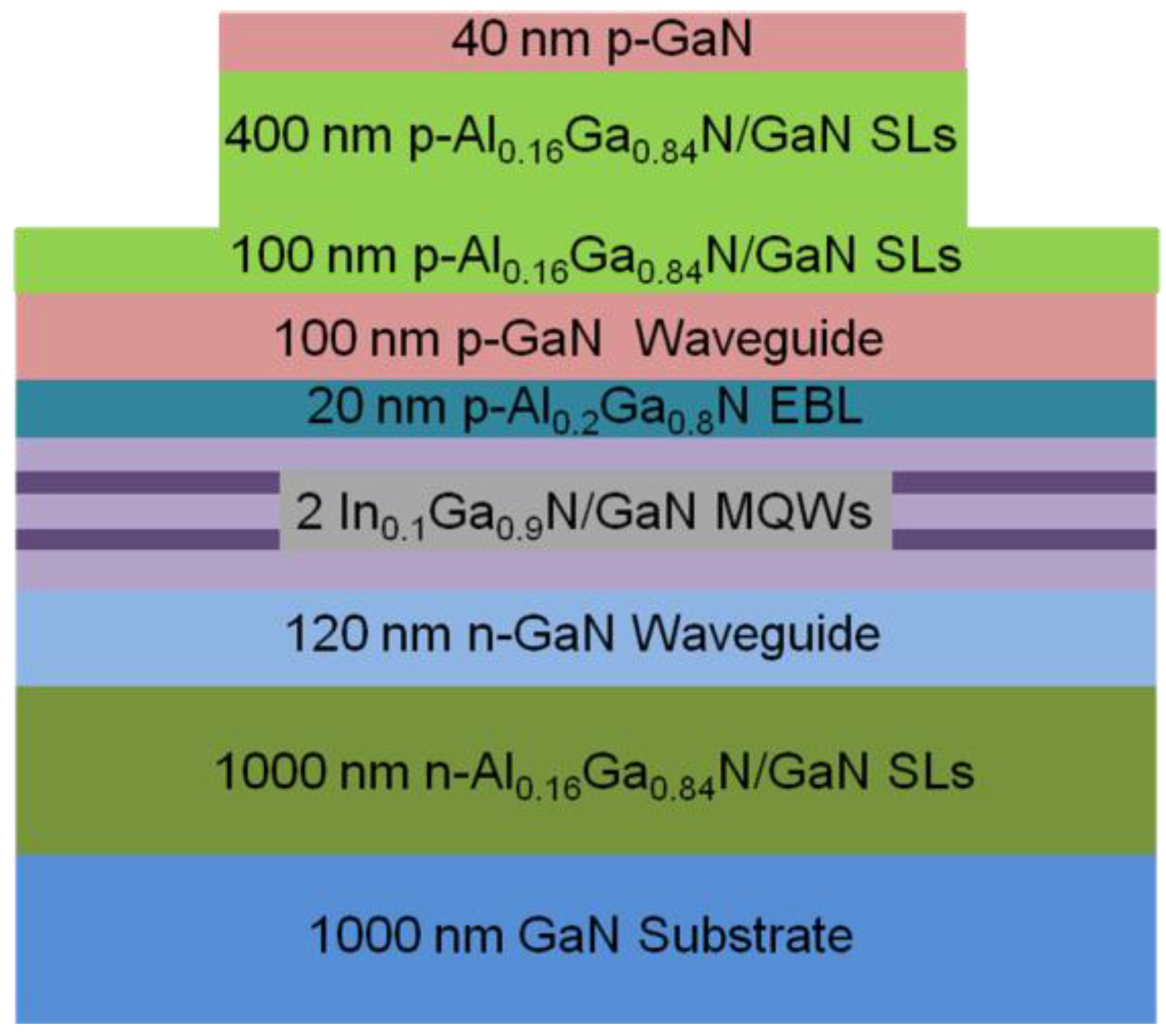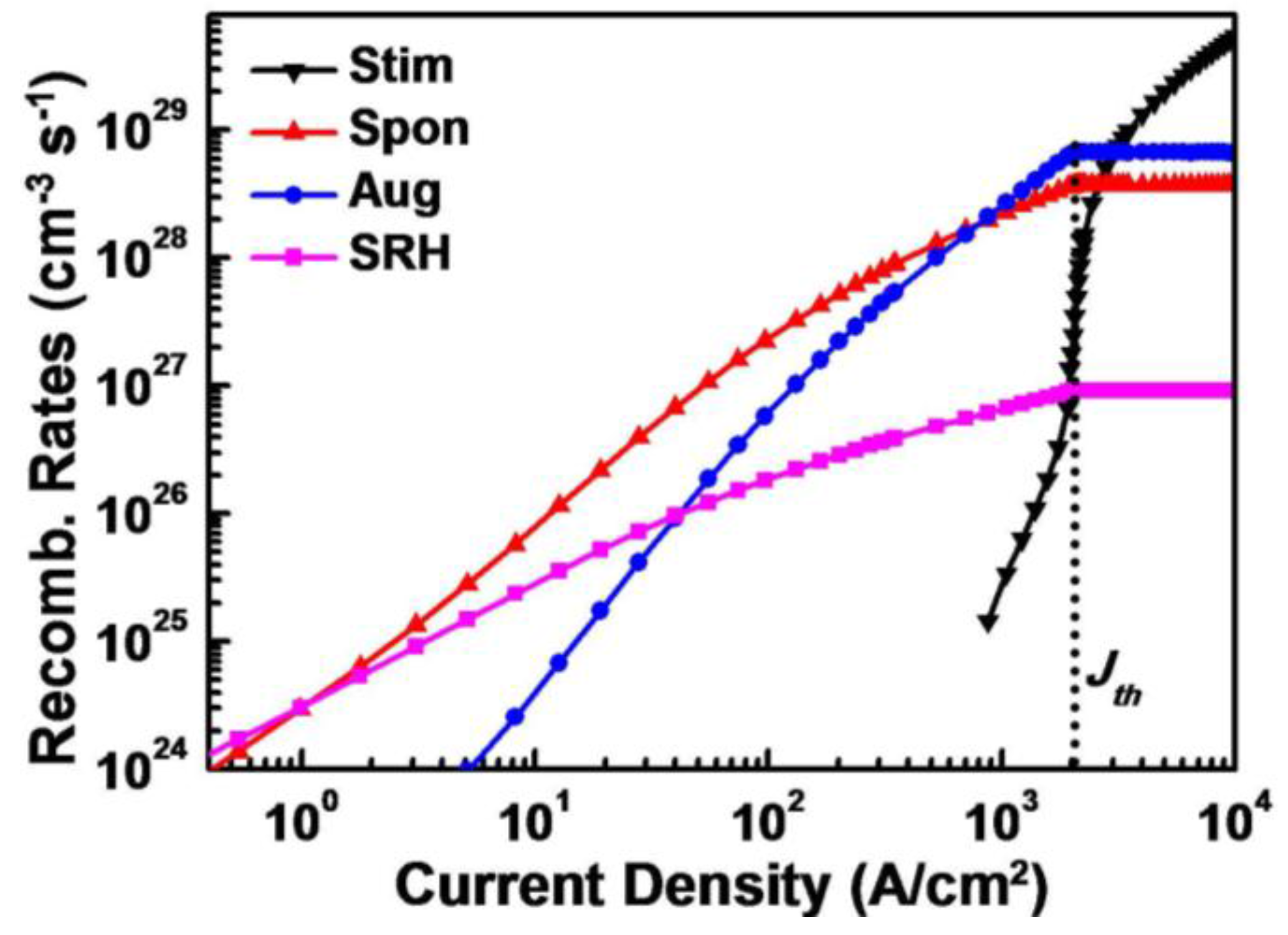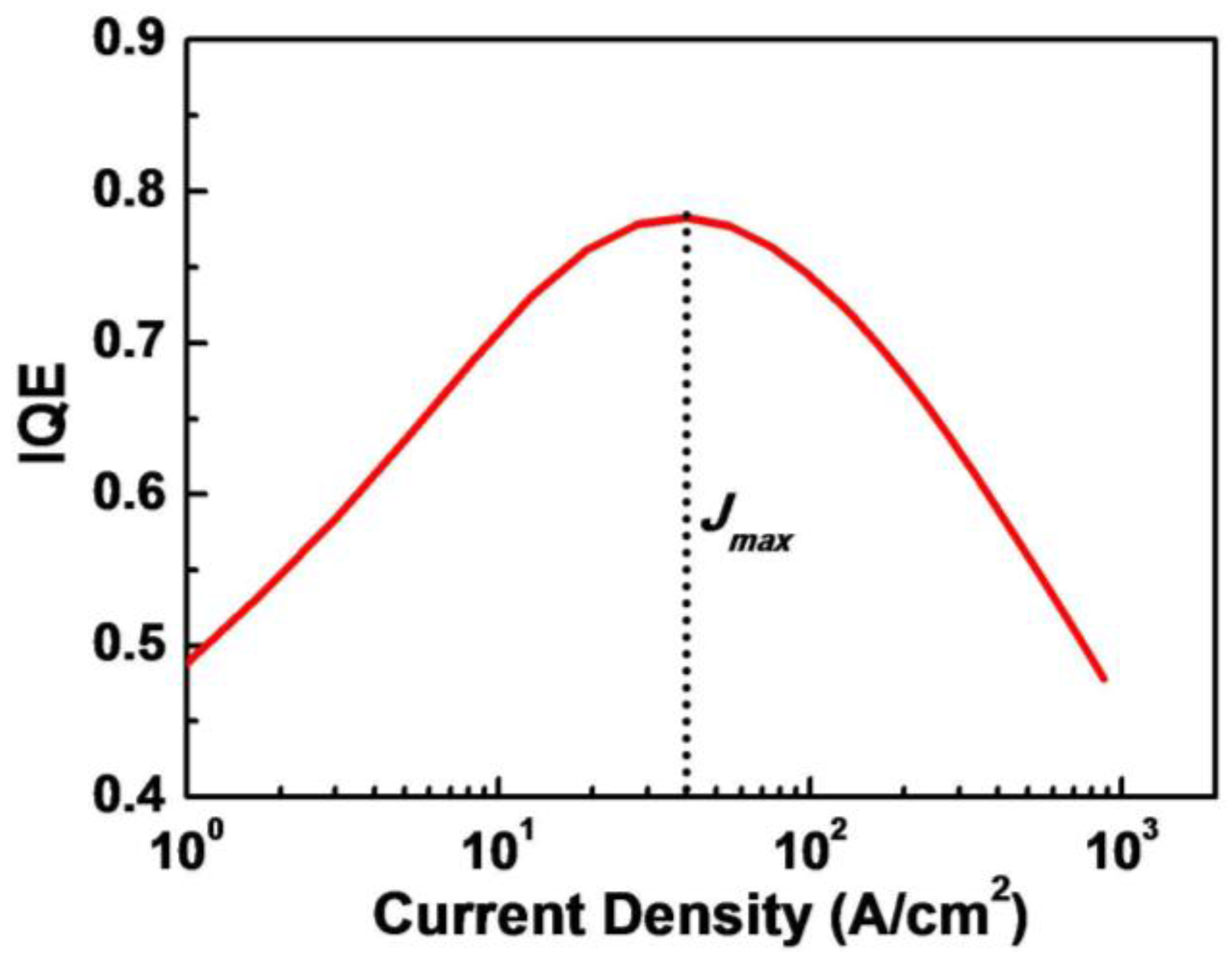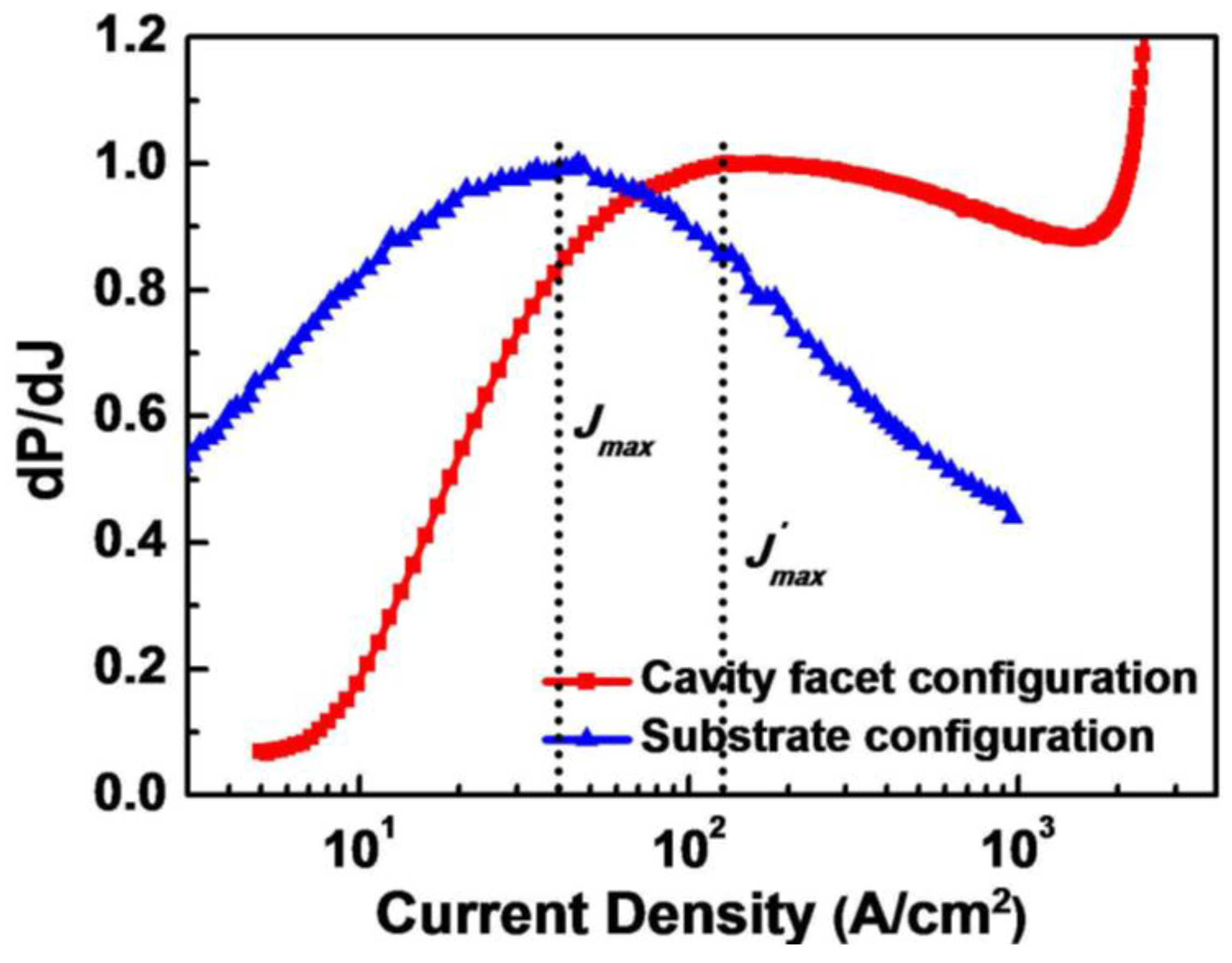A Study of Efficiency Droop Phenomenon in GaN-Based Laser Diodes before Lasing
Abstract
:1. Introduction
2. Experimental
3. Results and Discussion
3.1. Efficiency Droop Phenomenon
3.2. Influence of Auger Recombination
4. Conclusions
Acknowledgments
Author Contributions
Conflicts of Interest
References
- Zhao, H.P.; Liu, G.Y.; Arif, R.A.; Tansu, N. Current injection efficiency induced efficiency-droop in InGaN quantum well light-emitting diodes. Solid-State Electron. 2010, 54, 1119–1124. [Google Scholar] [CrossRef]
- Sun, Q.; Yan, W.; Feng, M.X.; Li, Z.C.; Feng, B.; Zhao, H.M.; Yang, H. GaN-on-Si Blue/White LEDs: Epitaxy, Chip, and Package. J. Semicond. 2016, 32, 044006-1–044006-8. [Google Scholar] [CrossRef]
- Krames, M.R.; Shchekin, O.B.; Mueller-Mach, R.; Mueller, G.O.; Zhou, L.; Harbers, G.; Craford, M.G. High-brightness AlGaInN light-emitting diodes. Proc. SPIE 2000, 3938, 2–12. [Google Scholar]
- Grzanka, S.; Perlin, P.; Czernecki, R.; Marona, L.; Bockowski, M.; Lucznik, B.; Leszczynski, M.; Suski, T. Effect of efficiency “droop” in violet and blue InGaN laser diodes. Appl. Phys. Lett. 2007, 95, 071108-1–071108-3. [Google Scholar] [CrossRef]
- Schwarz, U.T. Emission of biased green quantum wells in time and wavelength domain. Proc. SPIE 2009, 7216, 72161U-1–72161U-13. [Google Scholar]
- Lutgen, S.; Dini, D.; Pietzonka, I.; Tautz, S.; Breidenassel, A.; Lell, A.; Avramescu, A.; Eichler, C.; Lermer, T.; Müller, J.; et al. Recent results of blue and green InGaN laser diodes for laser projection. Proc. SPIE 2011, 7953, 79530G-1–79530G-12. [Google Scholar]
- Shen, Y.C.; Mueller, G.O.; Watanabe, S.; Gardner, N.F.; Munkholm, A.; Krames, M.R. Auger recombination in InGaN measured by photoluminescence. Appl. Phys. Lett. 2007, 91, 141101-1–141101-3. [Google Scholar] [CrossRef]
- Scheibenzuber, W.G.; Schwarz, U.T.; Sulmoni, L.; Dorsaz, J.; Carlin, J.-F.; Grandjean, N. Recombination coefficients of GaN-based laser diodes. J. Appl. Phys. 2011, 109, 093106-1–093106-6. [Google Scholar] [CrossRef]
- Iveland, J.; Martinelli, L.; Peretti, J.; Speck, J.S.; Weisbuch, C. Direct Measurement of Auger Electrons Emitted from a Semiconductor Light-Emitting Diode under Electrical Injection: Identification of the Dominant Mechanism for Efficiency Droop. Phys. Rev. Lett. 2013, 110, 177406-1–177406-5. [Google Scholar] [CrossRef] [PubMed]
- Feng, M.X.; Liu, J.P.; Zhang, S.M.; Liu, Z.S.; Jiang, D.S.; Li, Z.C.; Wang, F.; Li, D.Y.; Zhang, L.Q.; Wang, H.; et al. Saturation of the junction voltage in GaN-based laser diodes. Appl. Phys. Lett. 2013, 102, 183509-1–183509-4. [Google Scholar] [CrossRef]
- Feng, M.X.; Liu, J.P.; Zhang, S.M.; Jiang, D.S.; Li, Z.C.; Li, D.Y.; Zhang, L.Q.; Wang, F.; Wang, H.; Yang, H. Design Considerations for GaN-Based Blue Laser Diodes With InGaN Upper Waveguide Layer. IEEE J. Sel. Top. Quantum Electron. 2013, 19, 1500705-1–1500705-5. [Google Scholar] [CrossRef]
- Ryu, H.Y.; Ha, K.H.; Lee, S.N.; Jang, T.; Kim, H.K.; Chae, J.H.; Kim, K.S.; Choi, K.K.; Son, J.K.; Paek, H.S.; et al. Highly stable temperature characteristics of InGaN blue laser diodes. Appl. Phys. Lett. 2006, 89, 031122-1–031122-3. [Google Scholar] [CrossRef]
- Gotz, W.; Johnson, N.M.; Walker, J.; Bour, D.P.; Street, R.A. Activation of acceptors in Mg-doped GaN grown by metalorganic chemical vapor deposition. Appl. Phys. Lett. 1996, 68, 667–669. [Google Scholar] [CrossRef]
- Chang, J.-Y.; Kuo, Y.-K. Simulation of blue InGaN quantum-well lasers. J. Appl. Phys. 2003, 93, 4992–4998. [Google Scholar] [CrossRef]
- Huang, C.-Y.; Lin, Y.-D.; Tyagi, A.; Chakraborty, A.; Ohta, H.; Speck, J.S.; DenBaars, S.P.; Nakamura, S. Optical waveguide simulations for the optimization of InGaN-based green laser diodes. J. Appl. Phys. 2010, 107, 023101-1–023101-7. [Google Scholar] [CrossRef]
- Bernardini, F.; Fiorentini, V. Nonlinear macroscopic polarization in III-V nitride alloys. Phys. Rev. B 2001, 64, 085207-1–085207-7. [Google Scholar] [CrossRef]
- Sizov, D.S.; Bhat, R.; Heberle, A.; Song, K.; Zah, C. Internal Optical Waveguide Loss and p-Type Absorption in Blue and Green InGaN Quantum Well Laser Diodes. Appl. Phys. Express 2010, 3, 122104-1–122104-3. [Google Scholar] [CrossRef]
- Redaelli, L.; Martens, M.; Piprek, J.; Wenzel, H.; Netzel, C.; Linke, A.; Flores, Y.V.; Einfeldt, S.; Kneissl, M.; Tränkle, G. Effect of ridge waveguide etch depth on laser threshold of InGaN MQW laser diodes. Proc. SPIE 2012, 8262, 826219-1–826219-8. [Google Scholar]
- Kozodoy, P.; Hansen, M.; DenBaars, S.P.; Mishra, U.K. Enhanced Mg doping efficiency in Al0.2Ga0.8N/GaN superlattices. Appl. Phys. Lett. 1999, 74, 3681–3683. [Google Scholar] [CrossRef]





© 2017 by the authors. Licensee MDPI, Basel, Switzerland. This article is an open access article distributed under the terms and conditions of the Creative Commons Attribution (CC BY) license (http://creativecommons.org/licenses/by/4.0/).
Share and Cite
Feng, M.-X.; Sun, Q.; Liu, J.-P.; Li, Z.-C.; Zhou, Y.; Zhang, S.-M.; Yang, H. A Study of Efficiency Droop Phenomenon in GaN-Based Laser Diodes before Lasing. Materials 2017, 10, 482. https://doi.org/10.3390/ma10050482
Feng M-X, Sun Q, Liu J-P, Li Z-C, Zhou Y, Zhang S-M, Yang H. A Study of Efficiency Droop Phenomenon in GaN-Based Laser Diodes before Lasing. Materials. 2017; 10(5):482. https://doi.org/10.3390/ma10050482
Chicago/Turabian StyleFeng, Mei-Xin, Qian Sun, Jian-Ping Liu, Zeng-Cheng Li, Yu Zhou, Shu-Ming Zhang, and Hui Yang. 2017. "A Study of Efficiency Droop Phenomenon in GaN-Based Laser Diodes before Lasing" Materials 10, no. 5: 482. https://doi.org/10.3390/ma10050482






